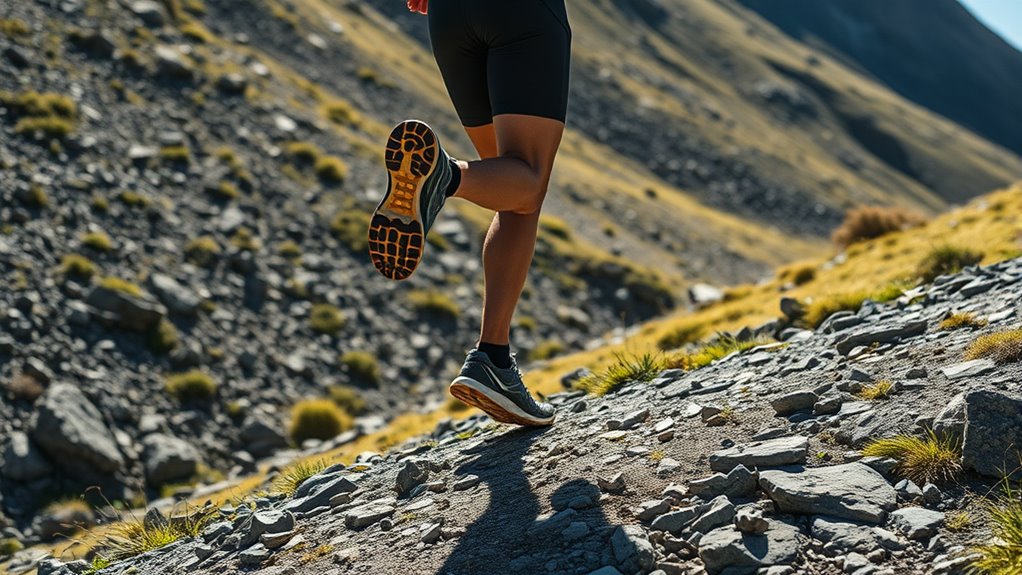To master downhill running without quad carnage, focus on proper biomechanics like a slight forward lean, flexible knees, and quick, light steps to reduce impact. Maintain a steady cadence, keep your foot placement under your hips, and use terrain awareness to adjust your stride. Strengthen your quads and core through specific drills and choose shoes with good traction. Paying attention to fatigue signs and incorporating recovery will keep you confident and injury-free—if you continue, you’ll uncover more tips to perfect your descent.
Key Takeaways
- Maintain a slight forward lean from the ankles to absorb impact and reduce quad strain.
- Shorten stride length and keep knees slightly flexed for better control and shock absorption.
- Increase cadence to promote quick, light steps that minimize impact forces on the quads.
- Strengthen supporting muscles and core to improve stability and reduce reliance on the quads during descent.
- Use proper footwear with deep lugs and traction, along with trekking poles, to enhance stability and reduce quad load.
Understanding the Mechanics of Downhill Running

Understanding the mechanics of downhill running is essential to improve your technique and prevent injuries. When you run downhill, your body must adapt to varied terrain, which influences your downhill biomechanics. Proper terrain adaptation means adjusting your stride and balance to handle uneven surfaces, loose gravel, or steep declines safely. Your downhill biomechanics involve slight forward lean, controlled cadence, and flexed knees to absorb impact. These adjustments help distribute forces evenly, reducing strain on your quads and knees. Recognizing how your body responds to downhill terrain allows you to optimize your movement and maintain stability. Additionally, understanding the role of projector contrast ratios can help you visualize terrain features more clearly, enhancing safety and efficiency. Being aware of how biomechanical adjustments can prevent overuse injuries is crucial for sustained downhill running. Incorporating muscle engagement strategies can further improve your stability and reduce fatigue over long downhill stretches. Paying attention to your terrain adaptation skills ensures a smoother and safer descent, especially on challenging slopes.
The Role of Proper Foot Placement and Posture

Proper foot placement and posture are essential for maintaining control and reducing impact during downhill running. When you land with your feet properly aligned beneath your hips, you enhance ankle stability, which helps absorb shocks and prevents injuries. Keep your gaze focused ahead to improve your mental focus, allowing you to react quickly to changes in terrain. Lean slightly forward from your ankles, not your waist, to stay balanced and avoid unnecessary strain on your quads. Shorter, controlled strides help you stay agile and maintain a steady rhythm. Engaging your core and keeping your posture upright minimizes unnecessary movement, conserving energy and reducing fatigue. Being mindful of your running form ensures efficiency and safety on downhill trails. Incorporating proper tanning tips like staying hydrated can also support your endurance and recovery. Paying attention to trail conditions allows you to adapt your technique for varying terrains, further enhancing your safety and performance. Additionally, understanding the importance of proper footwear can significantly impact your stability and comfort during downhill runs. With mindful foot placement and posture, you’ll run downhill more efficiently and with less risk of overexertion or injury.
Strengthening Your Quadriceps and Supporting Muscles

Building strength in your quadriceps and supporting muscles is essential for maintaining control and stability during downhill running. When steering trail terrain, robust muscles help absorb shocks and support proper downhill biomechanics, reducing fatigue and injury risk. To enhance these muscles, incorporate targeted exercises like squats, lunges, step-ups, and leg presses. Focus on gradually increasing resistance and volume to build endurance. Strengthening not only boosts your power but also improves balance and control on uneven surfaces. Remember, well-developed quads and supporting muscles contribute to smoother descents and less quad carnage. Regular training will improve your ability to handle steep declines, maintain proper posture, and stay injury-free during rigorous downhill runs. Incorporating training consistency into your routine ensures steady progress and long-term benefits. Additionally, integrating core stability exercises can further enhance your overall control and reduce unnecessary strain on the quads.
Technique Tips to Reduce Impact and Stress

To reduce impact and stress when running downhill, try shortening your stride to prevent overstriding. Keep your body slightly leaning forward, which helps absorb shock more effectively. These simple adjustments can make your downhill runs smoother and easier on your joints.
Shorten Stride Length
If you want to reduce the impact on your joints while downhill running, shortening your stride is a simple yet effective technique. By doing so, you improve stride efficiency and maintain better foot alignment, which helps absorb shock more effectively. A shorter stride reduces the pounding force on your knees and hips, lowering injury risk. Focus on landing with your foot underneath your hips, avoiding overextension.
Consider these tips:
- Keep your cadence high to naturally shorten your stride
- Engage your core to support stability
- Focus on quick, light steps to minimize impact
- Maintain a slight bend in your knees for better shock absorption
This approach helps you stay agile and reduces stress, making downhill running more comfortable and sustainable.
Lean Slightly Forward
Leaning slightly forward while running downhill helps you better absorb impact and reduce stress on your joints. Focus on posture analysis to guarantee your body stays aligned; avoid leaning too far forward, which can cause unnecessary strain. A slight forward lean engages your core and allows gravity to assist your descent, making your stride more efficient. Incorporate uphill training to build strength and improve your overall running form, which supports a balanced posture downhill. Keep your hips over your ankles and your shoulders relaxed. This posture minimizes braking forces and helps you maintain control without overloading your quads. Practicing this slight forward lean consistently will help you run downhill more smoothly, reducing fatigue and lowering injury risk.
The Importance of Pacing and Controlled Descents

To run downhill safely, you need to keep a steady rhythm and avoid rushing. Focus on your technique by leaning slightly forward and landing softly on each step. Maintaining control helps you conserve energy and reduces the risk of injury.
Maintain Steady Rhythm
Maintaining a steady rhythm is essential when downhill running, as it helps you conserve energy and stay balanced. Controlled pacing prevents overexertion and reduces impact stress. Focus on your breathing techniques to stay relaxed and oxygenate muscles efficiently, especially during longer descents. Proper nutrition planning beforehand ensures sustained energy without sudden drops. To keep your rhythm steady, consider:
- Monitoring your breathing to avoid rapid, shallow breaths
- Using short, controlled strides to maintain balance
- Staying relaxed to reduce muscle tension
- Adjusting your pace based on terrain and fatigue levels
Focus on Technique
Focusing on your technique is crucial when descending hills, as it directly influences your safety and efficiency. Proper pacing helps prevent unnecessary fatigue and reduces impact on your quads. Control your speed by engaging your core and leaning slightly forward, maintaining a smooth, controlled descent. Breath control is essential—deep, steady breaths keep your muscles oxygenated and your mind clear. Mental focus helps you stay present, avoiding distractions that could lead to missteps. Keep your steps deliberate, landing softly to absorb shocks and maintain balance. Remember, rushing downhill increases the risk of injury; instead, use technique and controlled breathing to stay relaxed and in control. Mastering these elements ensures you descend safely while conserving energy for the rest of your run.
Selecting the Right Gear for Downhill Stability

Choosing the right gear is essential for maintaining stability when running downhill. Proper gear selection helps you adapt to varying terrain and reduces the risk of slips or falls. Focus on footwear with aggressive grip and durable soles designed for terrain adaptation. Additionally, wear clothing that offers flexibility and breathability for better movement. Consider accessories like lightweight hydration packs or trekking poles for extra stability on steep descents. Good gear ensures you stay balanced, conserve energy, and prevent injury.
- Shoes with deep lugs and solid traction
- Breathable, flexible clothing for unrestricted movement
- Trekking poles for added stability
- Lightweight hydration packs for balance and endurance
Incorporating Specific Drills Into Your Training Routine

To improve your downhill running, you need to choose the right drills that target your specific needs. You should focus on integrating these exercises into your routine without disrupting your overall training plan. Strategic selection and proper timing of drills will help you build strength and confidence on downhill terrain.
Drill Selection Strategies
Integrating specific drills into your downhill running routine can considerably improve your technique and confidence on steep terrain. To do this effectively, focus on drills that address terrain variability and footwear selection, ensuring you’re prepared for different conditions. Choose drills that emphasize quick foot placement, control, and relaxed muscles to avoid quad carnage.
Consider incorporating:
- Trail-specific stride drills to adapt to uneven surfaces
- Balance exercises to improve stability on rocky or loose terrain
- Plyometric drills for quick, controlled foot movement
- Footwear trials to identify the best shoes for varied downhill conditions
Selecting the right drills helps you develop better proprioception, strength, and adaptability, making downhill running safer and more efficient.
Integrating Drills Effectively
Effective integration of drills into your downhill training requires intentional planning and consistency. Begin by selecting drills that target terrain adaptation, such as technical descending or controlled downhill strides, to build confidence on varying slopes. Incorporate these drills regularly into your routine, gradually increasing intensity and complexity. This consistency helps your body adapt to different terrains, reducing quad strain and improving stability. Additionally, focus on mental resilience by practicing drills that challenge your focus and composure, like timed descents or obstacle navigation. By deliberately combining terrain-specific exercises with mental resilience drills, you develop a well-rounded skill set. Over time, this approach enhances your ability to handle downhill runs smoothly and confidently, without overtaxing your quads.
Recognizing and Preventing Signs of Fatigue and Overuse

Recognizing the early signs of fatigue and overuse is crucial for maintaining safe and effective downhill running. When you notice persistent muscle soreness, joint pain, or a decline in form, it’s time to pause and reassess. Staying mindful helps prevent injuries and burnout. Incorporate nutrition tips like staying hydrated and fueling with carbs to sustain energy. Use mental strategies such as focusing on controlled breathing and positive self-talk to maintain motivation. Keep an eye out for:
Watch for early signs of fatigue like soreness, pain, or mental fog to prevent injury during downhill runs.
- Decreased coordination or balance
- Unusual muscle tightness
- Increased perceived effort
- Irritability or mental fog
Addressing these signs early allows you to adjust pace, incorporate rest, and avoid overtraining, ensuring you enjoy downhill runs without quad carnage. Recognizing these cues keeps you strong and injury-free.
Recovery Strategies to Minimize Soreness

After a tough downhill run, your muscles can feel sore and tight, but implementing targeted recovery strategies can help minimize these effects. Hydration tips are essential—drink plenty of water and electrolyte-rich fluids to replenish lost minerals and reduce muscle cramps. Proper hydration speeds up recovery and prevents dehydration-related soreness. Mental focus also plays a vital role; staying positive and relaxed helps your body recover faster. Gentle stretching and foam rolling can release tightness and improve blood flow, aiding muscle repair. Prioritize sleep, as it’s when your body naturally recovers and reduces soreness. By combining good hydration, mental focus, and active recovery techniques, you’ll reduce soreness and be ready for your next downhill adventure with less discomfort.
Building Confidence for Challenging Descents

Building confidence for challenging descents starts with proper preparation and mental readiness. To succeed, you need to develop terrain adaptation skills and boost your mental resilience. Practice on varied terrains to familiarize yourself with different surface conditions and improve your reaction time. Focus on maintaining a calm mindset, especially when facing steep or technical sections. Visualize successful descents to build trust in your abilities. Additionally, break down the descent into manageable segments, celebrating small wins along the way. Preparing physically with strength and flexibility exercises also helps reduce anxiety. Remember, mental resilience is key—stay positive, breathe steadily, and trust your skills. These strategies will help you approach difficult descents with confidence and control.
Frequently Asked Questions
How Can I Prevent Knee Pain During Downhill Running?
To prevent knee pain during downhill running, focus on proper knee stabilization and technique. Keep your knees slightly bent and engage your core to maintain balance. Shorten your stride and land softly to absorb impact better. Lean slightly forward from your hips instead of leaning back. Practicing these downhill techniques helps reduce strain, protect your knees, and keep you running comfortably downhill without pain.
What Are the Best Stretches for Downhill Running Recovery?
To aid your downhill running recovery, focus on stretching your hip flexors and calves. Hip flexor stretches help release tension in your hip area, reducing strain, while calf muscle recovery is essential for maintaining stability and preventing soreness. Incorporate gentle stretches like lunges or calf raises after your run. These targeted stretches boost flexibility, promote blood flow, and speed up recovery, helping you stay strong and pain-free on your next downhill adventure.
How Does Altitude Affect Downhill Running Performance?
Altitude affects your downhill running performance by lowering oxygen levels, which can cause fatigue and reduce endurance. Your body needs to adapt through altitude adaptation, increasing red blood cell production to improve oxygen delivery. Without proper adaptation, you might feel more breathless and tire quickly. To perform well at high elevations, train gradually, stay hydrated, and give your body time to adjust to the reduced oxygen levels.
Can Downhill Running Improve My Overall Running Speed?
Downhill running can definitely boost your overall speed by enhancing your running form and downhill biomechanics. When you practice downhill running, you learn to control your stride and reduce braking forces, making your movements more efficient. This improved technique translates to better performance on flat terrains, helping you run faster overall. Focus on maintaining good posture and a smooth stride, and you’ll see gains in your speed and endurance over time.
What Should I Do if I Experience Sharp Pain While Descending?
Think of sharp pain during downhill running as a warning sign, like a siren in a storm. You should immediately stop and assess your running form, ensuring your posture isn’t causing strain. Check your footwear selection—wearing supportive shoes can prevent unnecessary impact. If pain persists, ice the area and consider consulting a healthcare professional. Prioritize recovery over pushing through, to avoid long-term injury.
Conclusion
Just like a skilled mountain climber navigates treacherous slopes, mastering downhill running requires focus and finesse. By applying proper technique, strengthening your muscles, and pacing yourself, you’ll glide smoothly over rugged terrain instead of being overtaken by fatigue. Think of yourself as a flowing stream—steady, controlled, unstoppable. With patience and practice, you’ll conquer even the steepest descents, transforming challenge into confidence, and turning downhill runs into your personal victory parade.









